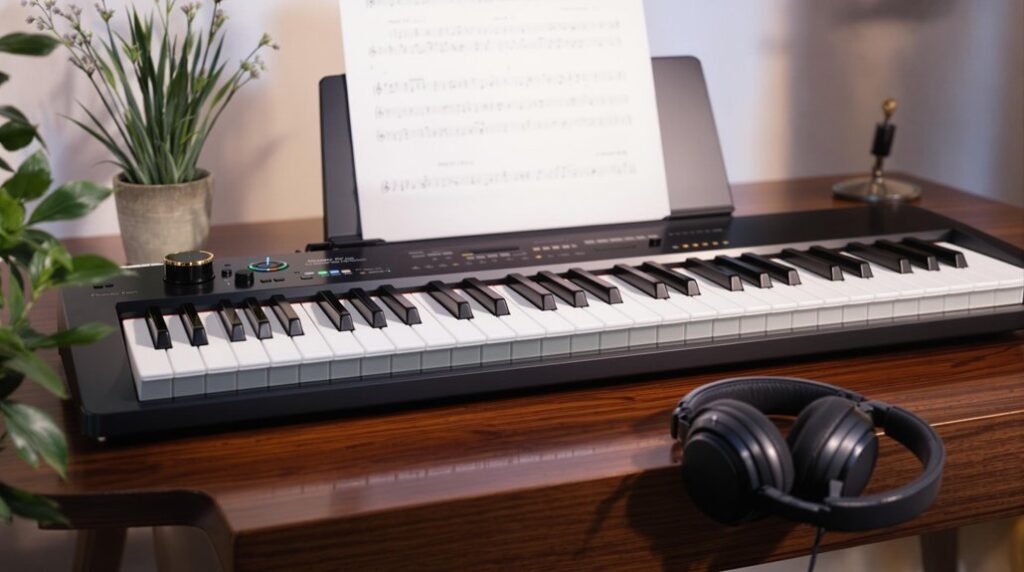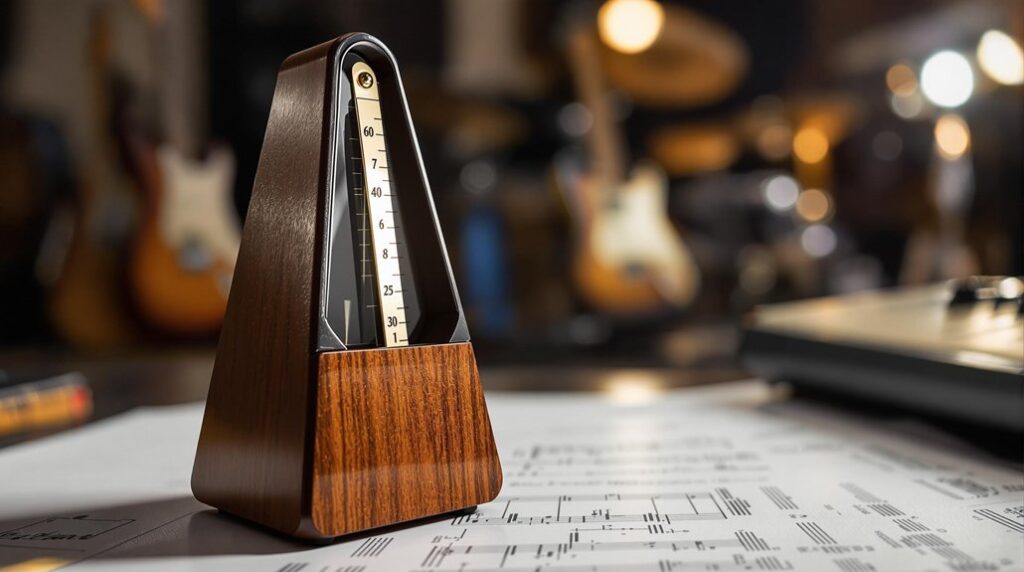Aspiring producers must adeptly navigate music notation to translate their creative ideas into tangible compositions. Start with mastering basic rhythms, particularly 4/4 and 6/8 time signatures, using a metronome to maintain precise timing. Understanding pitch notation—distinguishing between treble and bass clefs, and using ledger lines—enables accurate note placement. Grasp dynamics markings, such as pianissimo and forte, to add emotional depth and contrast. Finally, explore varied notational styles; whether it’s classical, jazz, or MIDI for electronics, each offers unique compositional tools and challenges. Delving into these aspects paves the way for an enriched musical journey.
Key Takeaways
- Master basic rhythms and time signatures, such as 4/4 and 6/8, for foundational composition skills.
- Understand pitch notation using treble and bass clefs to accurately represent musical notes on the staff.
- Practice dynamics markings to guide expressive performance and enhance emotional impact in compositions.
- Explore various notational styles, like standard, MIDI, and lead sheets, to suit different musical genres.
- Use notation software to visualize compositions and refine skills through structured practice and community engagement.
Master Basic Rhythms
Understanding and mastering basic rhythms is a fundamental skill for any music producer seeking to craft compelling compositions. In music theory, a solid grasp of rhythmic notation and time signatures is essential.
Music producers must recognize the value of note types: whole, half, quarter, and eighth notes, especially within a 4/4 time signature. These form the backbone of understanding basic rhythms. Counting rhythms aloud or tapping them out assists in internalizing these concepts, while practice with a metronome guarantees precise timing.
Familiarity with various time signatures like 3/4 and 6/8 further enhances a producer’s versatility. Utilizing rhythmic notation software aids visualization and practice, cementing these skills in music production. Mastery of the 6/8 time signature provides a rich rhythmic tapestry that can elevate compositions with its unique feel.
Mastery in this area leads to cohesive and rhythmically engaging tracks.
Understand Pitch Notation
Maneuvering through the intricate terrain of pitch notation is paramount for music producers aiming to accurately convey musical ideas.
In Western music, pitch notation utilizes staff lines, where each line and space represents specific notes. The treble clef indicates higher pitches, while the bass clef covers lower ranges.
Notes, depicted as oval symbols, vary in pitch based on their vertical placement. Accidentals, such as sharps and flats, alter these pitches, enhancing the complexity of composing music.
Octave designations like C4 guarantee precision across different octaves, allowing seamless communication among musicians.
Ledger lines extend beyond the standard five-line staff, accommodating a broader spectrum of notes. Mastery of these elements is essential for producers working to create dynamic and expressive compositions, as understanding chord progressions significantly enhances musical impact and emotional depth.
Practice Dynamics Markings
Enhance your compositions by mastering dynamics markings, an essential element that shapes the auditory environment of music.
These markings, including “p” for piano and “f” for forte, provide essential guidance for achieving expressive performance. By incorporating gradations like “mp” and “mf,” musicians and producers can infuse a piece with nuanced emotional shifts.
The use of crescendo and decrescendo is pivotal in arranging and mixing, as it helps articulate the dynamic flow and balance within a track. Such contrast not only enhances the impact of individual elements but also fosters a more engaging listening experience. Understanding musical notation is crucial for effectively applying these dynamics in your compositions.
Explore Notational Styles
Steering through the diverse terrain of music notation is essential for producers seeking to expand their creative and technical capabilities. Notational styles vary widely, influencing music composition across genres.
Classical music often relies on standard notation, whereas electronic music embraces MIDI and DAW-specific formats for seamless software integration. Understanding lead sheets is vital for flexibility in melody and chord progressions, fostering improvisation.
Graphic notation breaks traditional boundaries, using visual elements to express musical ideas. Meanwhile, tablature offers guitarists and bassists intuitive guidance without traditional notation.
Jazz notation, rich in chord symbols and rhythmic patterns, enhances collaborative efforts. Engaging in structured learning and joining online communities can further refine skills, offering diverse perspectives and innovative approaches to music composition. Mastery of harmonic mixing techniques can significantly enhance the quality of your compositions and performances.
Frequently Asked Questions
How to Write Good Music Notation?
To write effective music notation, master notation basics, rhythm patterns, and melody creation. Employ chord progressions, dynamic markings, and articulation techniques. Enhance skills through score reading and orchestration tips, utilizing digital notation and music software for precision.
What Knowledge Does a Music Producer Need?
A music producer needs thorough knowledge in music theory, sound design, mixing techniques, and genre exploration. Proficiency in software, sampling methods, arrangement strategies, and mastering basics is essential, alongside collaboration skills and awareness of evolving industry trends.
What Do Music Producers Struggle With?
Music producers often struggle with mastering music theory, beat matching, and sound design, while also facing challenges in arrangement techniques, workflow efficiency, and software limitations. Additional difficulties include genre exploration, mixing fundamentals, collaboration challenges, and time management.
Is 30 Too Old to Start Producing Music?
Age barriers are largely irrelevant in music production. Late starters at 30 can harness creative potential and navigate the learning curve effectively. With industry expectations, personal goals, musical passion, success stories, mentor support, and skill development, success is attainable.
Conclusion
The mastery of music notation is an essential skill for aspiring producers, providing a foundation for effective musical communication. An understanding of basic rhythms, pitch notation, dynamics markings, and various notational styles enhances the ability to convey musical ideas accurately and creatively. These elements collectively facilitate a nuanced interpretation and execution of compositions, enabling producers to craft intricate and expressive music. Consequently, a thorough grasp of these notational principles is indispensable for achieving proficiency and innovation in music production.




